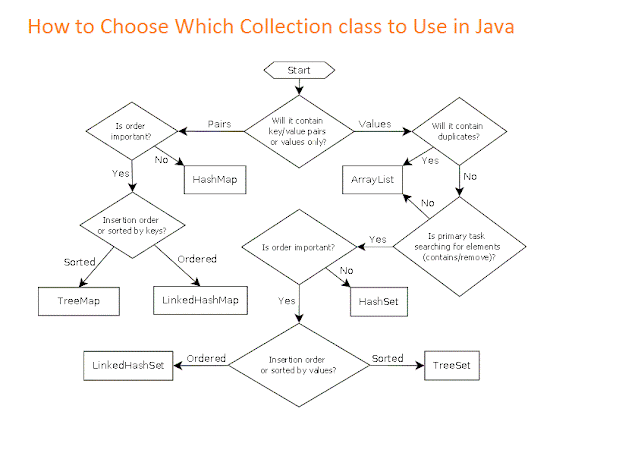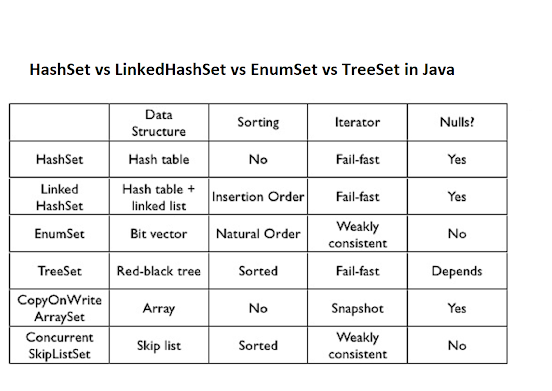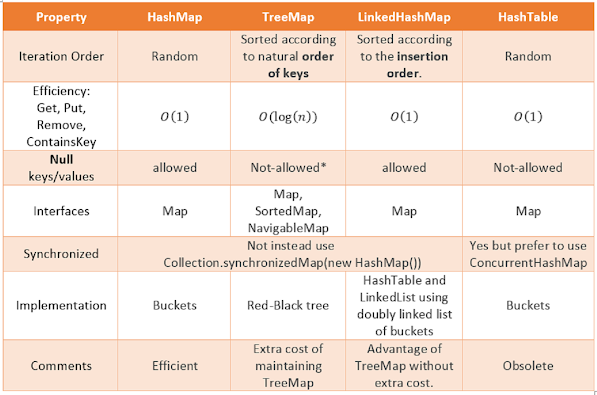The Java collection framework offers implementation of different data
structure like an array, list, set, map, queue, tree, etc and the choice
really depends upon the situation and properties of the different data
structure. For example, if your requirement is fast search with index then you
can use
ArrayList
and if you want to store key-value pairs then you would consider using hash
table data structure and there are a couple of implementation of hash table
data structure in Java, like HashMap,
Hashtable,
LinkedHashMap,
TreeMap, and
ConcurrentHashMap. Now, which one will you choose? If you don't know or confused don't worry, I will give you a set of rules and use cases which will help you choose the right Collection type in Java depending upon scenario.
Again if you need simple key-value pair storage then you using HashMap is fine but if you are concerned about thread-safety then you have three more options, synchronized HashMap, Hashtable and ConcurrentHashMap, the latter being better because of more Scalability.
Same if you are concern about the order because the map doesn't guarantee any order you can either use LinkedHashMap or TreeMap, the LinkedHashMap provides insertion order guarantee like it keeps mappings in the order they are inserted while TreeMap is a sorted map which keeps mapping in the sorted order defined by their Comparator or Comparable implementation.
So, it all boils down to your requirement and your understanding of different Collection classes in Java.
Again if you need simple key-value pair storage then you using HashMap is fine but if you are concerned about thread-safety then you have three more options, synchronized HashMap, Hashtable and ConcurrentHashMap, the latter being better because of more Scalability.
Same if you are concern about the order because the map doesn't guarantee any order you can either use LinkedHashMap or TreeMap, the LinkedHashMap provides insertion order guarantee like it keeps mappings in the order they are inserted while TreeMap is a sorted map which keeps mapping in the sorted order defined by their Comparator or Comparable implementation.
So, it all boils down to your requirement and your understanding of different Collection classes in Java.
In this article, I'll give you a brief and
comparative overview of essential interfaces from the Java collection
framework and highlight their unique properties which will help you to choose
the right Collection class for the job.
You can think of its popularity in the terms that there is hardly any Java application written which has not used any classes from the Java collection framework.
All important classes which you have used or heard like ArrayList, HashMap, Vector, LinkedList, Deque,BlockingQueue, all come from the Java collection framework.
In order to effectively use the Java Collection framework and choose the right type of Collection for the job, you need to know 4 basic interfaces like list, set, map, and queue.
How to find the right Collection class from Java Collection Framework?
The Java Collection framework is one of the most important API in JDK. It defines the implementation of the various data structure in Java language which makes it really important for Java developers to learn and understand.You can think of its popularity in the terms that there is hardly any Java application written which has not used any classes from the Java collection framework.
All important classes which you have used or heard like ArrayList, HashMap, Vector, LinkedList, Deque,BlockingQueue, all come from the Java collection framework.
In order to effectively use the Java Collection framework and choose the right type of Collection for the job, you need to know 4 basic interfaces like list, set, map, and queue.
- A List is an ordered collection that allows duplicates.
- A Set is an unordered collection that doesn't allow duplicate.
- A Map associates one object to another and provides an implementation of hash table data structure. It doesn't guarantee any order.
- A Queue is an interface which provides FIFO ordering of elements.
And, here is a quick guide of how to choose the right Collection for the job
in Java:
1. List
The List interface then has several implementations but two of the most important ones
are ArrayList and LinkedList. Former represent an array data structure while
later represents a linked list data structure.
Just like the array is suitable
for fast search, an
ArrayList
should be used if you need fast search and your data may or may not contain
duplicates.
A LinkedList is better for frequent addition and deletion but provides slow access, hence if you are processing data and frequently adding and removing from a list then the linked list can be a good choice. If you want to know more about them, I suggest you read when to ArrayList and LinkedList in Java.
A LinkedList is better for frequent addition and deletion but provides slow access, hence if you are processing data and frequently adding and removing from a list then the linked list can be a good choice. If you want to know more about them, I suggest you read when to ArrayList and LinkedList in Java.
2. Set
The Set interface has three main implementations HashSet, TreeSet, and LinkedHashSet. The HashSet is based upon Hashtable but it doesn't associate one object to other, it just stores them with default values. If you need a general-purpose set to store unique values, you can use HashSet.LinkedHashSet provides ordering and uniqueness and should be used to maintain unique elements in the order they are inserted into the set.
The TreeSet arrange elements in the order defined by their Comparator or Comparable and if you need to keep elements sorted, this is the set you can use. Here is a nice tabular summary of difference between HashSet, TreeSet, and LinkedHashSet as well other different types of Set classes in Java on different parameters e.g. data structure, sorting, iterator and how they handle null input.
3. Map
The Map interface also comes with a couple of implementations e.g. HashMap, Hashtable, and LinkedHashMap.The HashMap is your general-purpose if you need to associate one object to other e.g. id to name then you can use this. It provides a fast lookup if you know the key but it doesn't guarantee any order.
The LinkedHashMap solves that problem by providing an ordering guarantee because it keeps all mappings in the order they are inserted into the map.
The Hashtable is a synchronized version of HashMap, it's a legacy class and best to avoid in favor of more scalable alternatives like ConcurrentHashMap.
There is also a TreeMap which like TreeSet keeps mappings in the sorted order defined by their Comparator and Comparable implementations. Here is a nice table of differences between HashMap, LinkedHashMap, and TreeMap in Java:
4. Queue
The Queue interface provides a FIFO structure like First In First Out. There are a couple of queue implementations available in JDK e.g. PriorityQueue, BlockingQueue, and LinkedList.You can use PriorityQueue to process elements in priority e.g. always processing a high priority item first. It's good for scheduling jobs and other things that are processed on priority.
A BlockingQueue is used for thread-safety and workflow. You can use it to implement a Producer-consumer pattern like where one thread can add objects into the queue and others can consume it.
This is just an example, in this article, we are going to explore other important Collection classes to learn how to choose the right type of Collection for the job.
Other Java Collections Tutorial and Interview Questions
- Difference between HashSet, TreeSet, and LinkedHashSet in Java? (answer)
- 50 Java Programs from Coding Interviews (list)
- Difference between HashMap and ArrayList in Java? (answer)
- 10 Java Garbage Collection Interview Questions (list)
- What is the difference between HashSet and ArrayList in Java? (answer)
- 21 Java Final modifier Interview Questions (list)
- What is the difference between ArrayList and LinkedList in Java? (answer)
- 21 Java Inheritance Interview Questions with Answers (list)
- 5 differences between HashMap and Hashtable in Java? (answer)
- 10 Date, Time, and Calendar based Interview Questions with Answers (list)
- How to use NavigableMap in Java 6? [example]
- 10 Example of ConcurrentHashMap in Java? (concurrenthashmap)
- How to use BlockingQueue in Java Program? [example]
- 25 Java Collection Interview Questions with Answers (collections)
- Top 5 Courses to learn Java Collections Framework in-depth (courses)
Thanks for reading this article so far. If you like this tutorial then please share with your friends and colleagues. If you have any questions or feedback then please drop a note.
















No comments :
Post a Comment